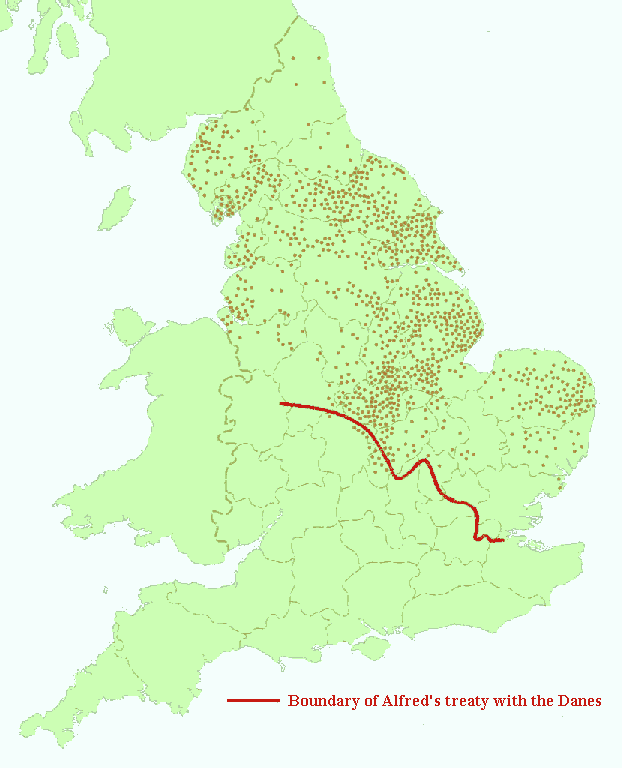英語史に関連するイングランド地図で,これほど明快な地図はないのではないか.イングランドに残る古ノルド語要素を含む地名の分布を表わす地図である( Crystal, p. 25 をもとに作成).

赤い線は,878年,攻め入るデーン人を King Alfred が Eddington で打ち負かし,ウェドモア条約 (Treaty of Wedmore) を締結したときに定まったアングロサクソン領とデーン領の境界線である.境界線の北部はデーン人の法律が適用される地域ということで,the Danelaw と呼ばれることになった.イングランドには古ノルド語要素を含む地名が1400以上あるとされるが,そのほとんどが the Danelaw 地域にきれいに限定されているのが印象的である.主要な古ノルド語要素を挙げると以下のようなものがある.
・ -by 「町」: Derby, Rugby, Whitby
・ -thorpe 「村落」: Althorp, Bishopsthorp, Gawthorpe, Linthorpe, Mablethorpe, Scunthorpe
・ -thwaite 「開墾地」: Applethwaite, Braithwaite, Rosthwaite, Stonethwaite, Storthwaite
・ -toft 「家屋敷」: Eastoft, Langtoft, Nortoft
これらのノルド語要素は複合地名の後半部分に用いられているが,前半部分は必ずしも古ノルド語起源とは限らず英語要素であることも多い.例えば,Storthwaite では前半要素 stor は古ノルド語で「大きい」を意味する語であり,前半後半両要素とも北欧系だが,Stonethwaite では前半要素は明らかに英語の stone を示しており,両言語混在型の地名である.
複合地名に両言語の要素が含まれているということは,両民族が平和に共存していた可能性を強く示唆する.もしデーン人がアングロサクソンの町村を武力で制圧しアングロサクソン系住民を駆逐したのであれば,新たな地名に英語要素を含めるということは考えにくい.両言語の要素が1つの地名に混在しているということは,両民族の血縁的な混合も同時に進んでいたことを表わしているのではないか.そして,この密な混合は,古ノルド語が英語に計り知れない影響を及ぼし得たのはなぜかという問題に解答を与えてくれるのである.
・ Crystal, David. The Cambridge Encyclopedia of the English Language. 2nd ed. Cambridge: CUP, 2003.